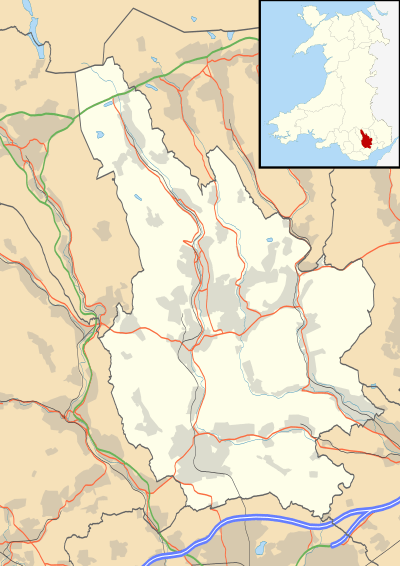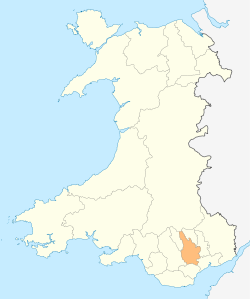Aberbargoed
Aberbargoed (Welsh: Aberbargod) is a small town in the Welsh county borough of Caerphilly, within the historic boundaries of Monmouthshire, south Wales. Aberbargoed once contained the largest ever colliery waste tip in Europe,[1] although this has now been reclaimed and turned into a country park.
Aberbargoed
| |
|---|---|
 Aberbargoed Location within Caerphilly | |
| Population | 9,184 |
| OS grid reference | SO155005 |
| Principal area |
|
| Country | Wales |
| Sovereign state | United Kingdom |
| Post town | CAERPHILLY |
| Postcode district | CF81 |
| Dialling code | 01443 |
| Police | Gwent |
| Fire | South Wales |
| Ambulance | Welsh |
| UK Parliament | |
| Senedd Cymru – Welsh Parliament |
|
Mining
Coal mining operations in Bargoed Colliery started in 1897 when the Powell Duffryn Steam Coal Company started to sink the shaft. In 1901, the "Ras Las" nine-foot seam was discovered at a depth of 625 yards. The north and south shafts were completed. In November 1903, Sir Alfred Thomas, M.P. for East Glamorgan, started the engines to raise the first four trams of coal.
By 1910, the pit was employing 1,943 miners and was the largest coal mine in the Rhymney Valley. On 10 December 1908, it broke the world record for production when a ten-hour shift produced 3,562 tons of coal. It further broke its own record on 23 April 1909 when 4,020 tons were raised in a ten-hour shift.
Bargoed Colliery closed on 4 June 1977. By this time, only 360 men were employed there. There is a legend that has it, The Flame lived in Aberbargoed for 27 years before moving to Penpedairheol
Population
The population of Pont Aberbargoed was 351 in the census of 1851. Aberbargoed reached a peak in 1961 of 5,157, and had dropped to 3,882 according to the 1991 Census. Bargoed in 1921 had a population of 2, dropping to 1 by 1991.[2]
Modern Day
The coal-mining waste tip that lay between Bargoed and Aberbargoed once towered to a height of 400 feet in the 1970s. The local school had a Plant a tree in '73 campaign in an attempt to make it more pleasurable on the eye. The tip has now been levelled and the area has been reclaimed with walkways. The colliery has gone and is now home to an Ambulance Station and other small industries.
There are also developments with a new retail outlet in the area where the tip once stood.
The large tip at Bedwellty is still there, but has been grassed over and now looks much like the surrounding countryside.
Aberbargoed now has an extensive area of grasslands that are protected due to the finding of a rare butterfly: the Marsh fritillary Euphydryas aurinia has been found in the marshy area north of where Bedwellty School once stood. Recently a bypass has been built through the park allowing road users to bypass the town of Bargoed.
Notable people
- Sir Harold Josiah Finch (politician)
- The jazz pianist and composer Geoff Eales was born in Aberbargoed.
- Luke Evans (actor)
- Listed on the War Memorial in the middle of the village is the name of Glyndwr Michael. His body, given the fictional name of "Major Martin", was used in "Operation Mincemeat", a deception operation by British Intelligence during World War II.
References
- "the largest ever man made colliery waste tip in Europe". www.caerphilly.gov.uk. 9 February 2011. Retrieved 9 February 2011.
- "Population figures from 1991 census". www.welshicons.org. 8 February 2011. Archived from the original on 1 January 2011. Retrieved 8 February 2011.
Bibliography
James, Paul (2002). The History of Bargoed, Gilfach and Aberbargoed in Photographs, Vol. 3. Old Bakehouse Publications. ISBN 1-874538-64-6.
Gelligaer Historical Society (1972). Gelligaer. Gelligaer Historical Society.
